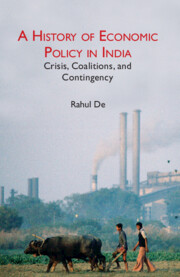Book contents
- Frontmatter
- Contents
- List of Figures and Tables
- Preface
- Acknowledgments
- List of Abbreviations
- Introduction
- 1 Colonialism and the Indian Economy
- 2 The Drive to Industrialize under Nehru's Leadership: 1950–66
- 3 The Turn to Populism under Indira Gandhi: 1967–79
- 4 The Early Liberalization Years: 1980–2003
- 5 Maturity of Reforms in the UPA Years: 2004–13
- 6 Reforms under the NDA Government: 2014–19
- Index
4 - The Early Liberalization Years: 1980–2003
Published online by Cambridge University Press: 14 September 2023
- Frontmatter
- Contents
- List of Figures and Tables
- Preface
- Acknowledgments
- List of Abbreviations
- Introduction
- 1 Colonialism and the Indian Economy
- 2 The Drive to Industrialize under Nehru's Leadership: 1950–66
- 3 The Turn to Populism under Indira Gandhi: 1967–79
- 4 The Early Liberalization Years: 1980–2003
- 5 Maturity of Reforms in the UPA Years: 2004–13
- 6 Reforms under the NDA Government: 2014–19
- Index
Summary
‘Liberalization’ is imagined as a magic bullet that makes economic processes and allocation of resources efficient, competitive, and meritocratic. However, liberal reforms are anything but one thing; implementation of liberal policies can be radically different in sequence and pace and quite tricky to evaluate without understanding the context. In this chapter, I will not attempt to evaluate whether liberal reforms were a success or failure in India, but will instead try to analyze the conditions – politics, social context, economic dynamics, and contingent events – which shaped the timing of the introduction and the pace and sequence of reform policies.
Liberalization is linked to 1991 for most informed Indians and is perceived as a watershed moment when the Indian economy emerged from the heavy state-centric “license Raj” regime and entered its modern high-growth phase. The National Council of Educational Research and Training's (NCERT) class 11 textbook explains liberalization in 1991 as follows: “India agreed to the conditionalities of World Bank and IMF and announced the new economic policy [NEP]. The NEP consisted of a wide range of economics reforms” (NCERT 2023 [2006], 39). However, I will contest the claim that liberalization was introduced in 1991 and instead argue that the economy had already been reoriented towards private enterprise and markets since the return of the Indira-led INC government in 1980; there were few liberal reforms introduced in 1991, and reforms introduced in the 1990s did not significantly impact growth, investment, or industrial growth. To explain these arguments, I will focus on two specific questions: what were the events that led to the introduction of reforms in India, and why is liberalization linked to 1991?
What Are Liberal Reforms?
Liberal reforms renew the beliefs of early modern and especially 19th-century “classical” liberalism that economic growth will be most rapid with the existence of unfettered markets unimpeded by government regulation. The free movement of the price mechanism will create conditions for the most efficient allocation of goods, services, and capital. The efficacy of “free markets” was based on a myth that the international economic system was free – in the sense of being self-regulating, with natural flows of money and capital – before WW1 which contributed to significant growth in the global economy. As I had argued in Chapter one, the global economy before WW1 was inequitable and supported the appropriation of resources and labor from the Third World to the First World.
- Type
- Chapter
- Information
- A History of Economic Policy in IndiaCrisis, Coalitions, and Contingency, pp. 96 - 122Publisher: Cambridge University PressPrint publication year: 2024



